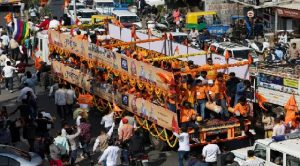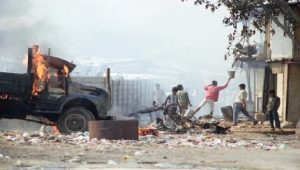22-01-2024
Bureau Report + Agencies
NEW DELHI/ YAVATMAL/ MUMBAI: For a month now, mini-trucks have been snaking their way on labyrinth roads cutting across villages in Yavatmal district in central India.
 Yavatmal has been in the grip of agrarian distress so deep that more than 5,800 farmers have taken their own lives here in the last two decades, according to data provided by the local divisional collectorate but these trucks haven’t been carrying any relief for distressed farmers. Instead, with a photo of the Hindu god Ram on posters stuck on their sides, the trucks have been foraying deep inside the district, exhorting farmers to donate grains.
Yavatmal has been in the grip of agrarian distress so deep that more than 5,800 farmers have taken their own lives here in the last two decades, according to data provided by the local divisional collectorate but these trucks haven’t been carrying any relief for distressed farmers. Instead, with a photo of the Hindu god Ram on posters stuck on their sides, the trucks have been foraying deep inside the district, exhorting farmers to donate grains.
The grains are headed to Ayodhya to feed hundreds of thousands of devotees visiting the city where Prime Minister Narendra Modi will consecrate a temple to Ram on January 22, over three decades after a mob led by Hindu nationalists tore down a mosque that stood on the spot.
The trucks are being operated by the Vishwa Hindu Parishad (VHP), a part of the Hindu nationalist network Sangh Parivar led by the Rashtriya Swayamsevak Sangh (RSS) that includes Modi’s Bharatiya Janata Party (BJP).
At Yavatmal’s Samvidhan Chowk, workers hurriedly load a large container truck with sacks of grains. “We have managed to fill three container trucks with these donations, and this is the fourth one,” says VHP Vidarbha Prant President Raju Niwal. The idea, VHP volunteers on the spot say, is to mobilise farmers and make them “feel involved” in the celebrations.
 It’s a sentiment that the Modi government and its ideological allies have successfully managed to evoke across the country.
It’s a sentiment that the Modi government and its ideological allies have successfully managed to evoke across the country.
For over seven decades, the movement to build the Ram temple in Ayodhya, at the spot where he is believed to have been born according to Hindu scriptures, had been shrouded in violence and bitter contestation. Close to 2,500 people (PDF), according to a research paper by the Institute of Peace and Conflict Studies, were killed during the violence that broke out around the BJP-led agitation demanding a Ram temple in the early 1990s but as Modi gets set to inaugurate the Ram temple, the country has been flooded by popular culture acts and symbols that ignore that troubled past, giving the Ram temple movement a benign image, and creating a lasting legacy for Modi among Hindus, say analysts.
From social media timelines to schools, the temple’s inauguration is everywhere. Music platforms are filled with a glut of new songs exhorting citizens to celebrate the occasion, insisting that Ram was “coming back”. New TV shows have come up around Ram’s life. Reality TV shows have dedicated entire episodes to songs hailing Ram, with a makeshift temple built in the studio. News television channel vehicles are sporting huge Ram stickers, while news studios feature large cutouts of Ram as the backdrop for news debates. India’s largest domestic airline, Indigo, got its cabin crew to dress up as Ram, wife Sita and brother Lakshman, in its inaugural flight to Ayodhya from Ahmedabad.
 Pressmediaofindia
Pressmediaofindia




